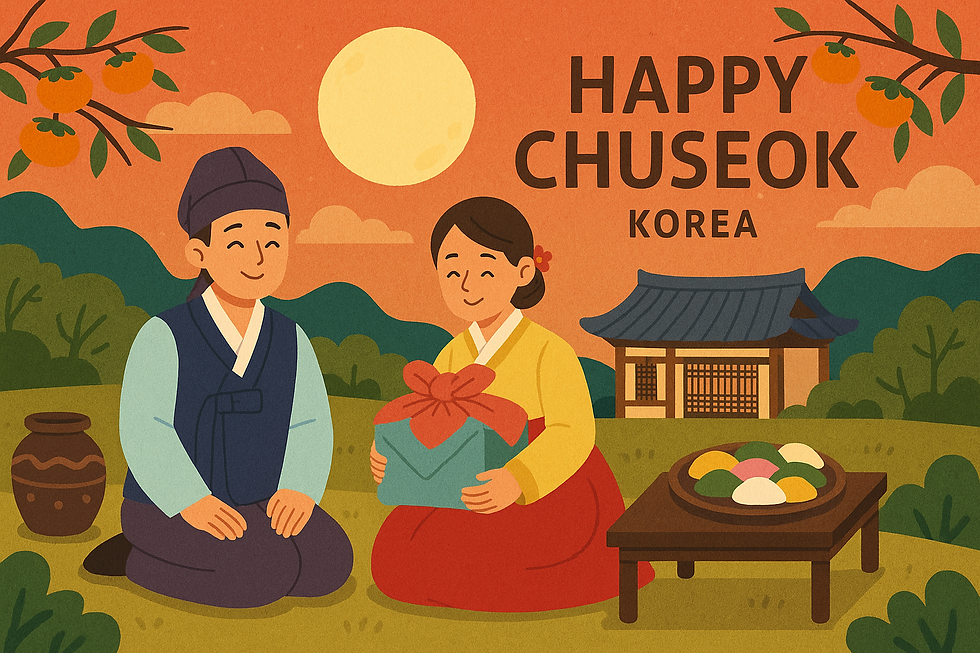Key Dates in the Korean Calendar
- FLip Korea

- Sep 22
- 4 min read
Updated: Sep 22
South Korea has a rich cultural heritage, and its calendar reflects this with many important dates and festivals. Knowing these key dates can help you plan your visit or stay in Korea better. You will find that many holidays are deeply rooted in tradition, while others celebrate modern achievements. This post will guide you through the most important dates in the Korean festive calendar, explaining their significance and how they are celebrated.
Understanding the Korean Festive Calendar
The Korean festive calendar combines both the solar (Gregorian) calendar and the traditional lunar calendar. Some holidays follow the solar calendar, like New Year's Day on January 1st, while others, such as Chuseok, are based on the lunar calendar and change dates each year.
For example, Seollal, the Korean Lunar New Year, usually falls in late January or early February. It is one of the most important holidays in Korea. Families gather to perform ancestral rites, eat traditional foods like tteokguk (rice cake soup), and play folk games.
If you want to keep track of all these dates easily, you can check a reliable korean holiday calendar that updates annually with both lunar and solar dates.

Major Korean Holidays and Their Traditions
Here are some of the key holidays you should know about:
Seollal (Korean Lunar New Year)
Seollal is a three-day celebration marking the start of the lunar new year. It usually involves:
Paying respects to ancestors through a ritual called charye.
Wearing traditional clothing called hanbok.
Eating tteokguk, which symbolizes growing a year older.
Playing traditional games like yutnori.
This holiday is a time for family reunions and honoring heritage.
Chuseok (Korean Harvest Festival)
Chuseok is often called the Korean Thanksgiving. It is celebrated on the 15th day of the 8th lunar month. During Chuseok, people:
Visit their ancestral hometowns.
Perform charye to honor ancestors.
Share a feast of freshly harvested rice, fruits, and Korean pancakes called jeon.
Enjoy folk games and dances.
Chuseok is a joyful time to give thanks for the harvest and spend time with family.
Hangul Day (October 9)
Hangul Day celebrates the creation of the Korean alphabet by King Sejong the Great. It is a public holiday in South Korea. On this day, you can expect:
Cultural events promoting the Korean language.
Exhibitions and performances.
Educational programs about Hangul’s history.
This holiday highlights Korea’s unique linguistic heritage.

Children’s Day (May 5)
Children’s Day is a special day to celebrate children’s happiness and well-being. Families often:
Take children to amusement parks, zoos, or museums.
Give gifts and treats.
Participate in community events.
It is a fun and lively holiday focused on family and children.
Buddha’s Birthday (Varies by lunar calendar)
Buddha’s Birthday is celebrated on the 8th day of the 4th lunar month. Temples across Korea are decorated with colorful lanterns. Activities include:
Visiting temples.
Participating in lantern parades.
Offering prayers and food to monks.
This holiday reflects Korea’s Buddhist traditions and spiritual culture.
How to Plan Around Korean Holidays
When you plan your trip or move to Korea, it is important to consider these holidays. Many businesses and government offices close during major holidays like Seollal and Chuseok. Public transportation can be crowded as people travel to their hometowns.
Here are some tips to help you navigate:
Check the dates early - Since some holidays follow the lunar calendar, dates change every year.
Book accommodations and transport in advance - Especially around Seollal and Chuseok.
Respect local customs - If you visit during holidays, observe traditions and dress appropriately.
Try traditional foods - Holidays are the best time to enjoy authentic Korean dishes.
Join public celebrations - Many cities host festivals and events open to tourists.
By planning ahead, you can enjoy the festive atmosphere without inconvenience.

Other Notable Dates in the Korean Calendar
Besides the major holidays, there are other important dates worth noting:
Independence Movement Day (March 1): Commemorates the 1919 movement against Japanese colonial rule.
Memorial Day (June 6): Honors soldiers who died for Korea.
Liberation Day (August 15): Marks Korea’s liberation from Japanese occupation in 1945.
National Foundation Day (October 3): Celebrates the founding of the Korean nation.
Christmas Day (December 25): A public holiday with growing popularity.
These dates often involve ceremonies, parades, and public events. They provide insight into Korea’s modern history and national pride.
Staying Updated with the Korean Holiday Calendar
To make the most of your time in Korea, staying updated on the korean holiday calendar is essential. This resource provides:
Accurate dates for both lunar and solar holidays.
Information on public holidays and observances.
Tips on how holidays affect business hours and transportation.
Using this calendar will help you avoid surprises and plan your activities smoothly.
Understanding the key dates in the Korean festive calendar opens a window into the country’s culture and traditions. Whether you are visiting, working, or living in Korea, knowing these holidays will enrich your experience. You will appreciate the deep respect Koreans have for family, history, and community. Keep this guide handy, and enjoy the vibrant celebrations throughout the year.



Comments